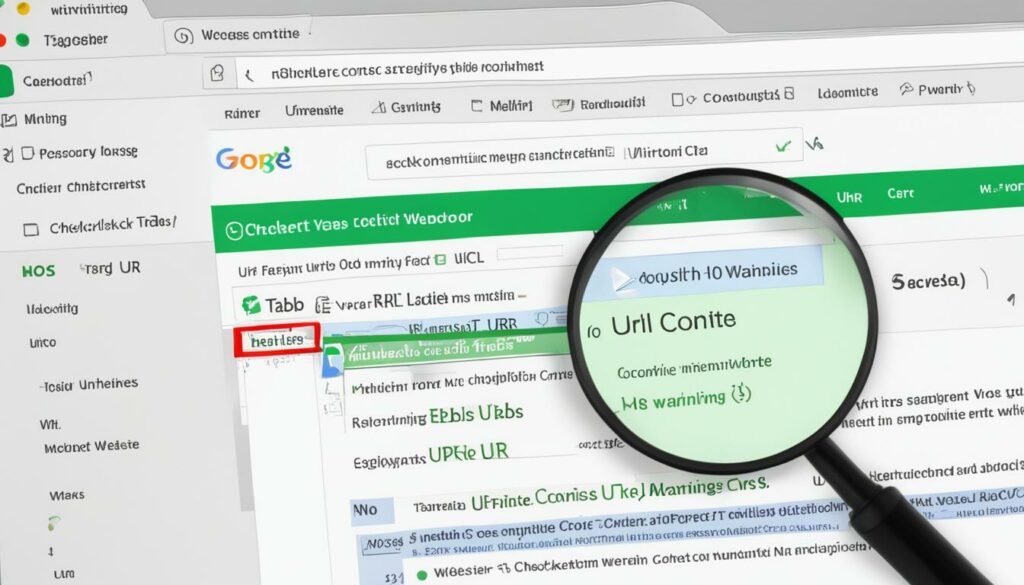Running your site over HTTPS is crucial for website security, trust, search engine ranking, and accurate referral data. However, during the migration from HTTP to HTTPS, many website owners encounter mixed content warnings, which can impact user experience and pose security vulnerabilities.
So, what exactly are mixed content warnings? They occur when a website loads both secure HTTPS and insecure HTTP content simultaneously. This can happen when absolute paths, hardcoded image URLs, or HTTP versions of external scripts are used. Popular browsers like Chrome, Firefox, and Microsoft Edge display strict warnings to visitors, highlighting the presence of mixed content on the site.
To ensure the security and integrity of your website, it is crucial to fix these mixed content warnings promptly. By updating the HTTP resources and ensuring all content is served over HTTPS, you can eliminate these warnings and provide a secure browsing experience for your visitors.
There are various methods and tools available to help you fix mixed content issues. From identifying the resources still loading over HTTP to performing search and replace operations, you have the power to secure your website and maintain a seamless user experience.
Key Takeaways
- Fixing mixed content issues is vital for a secure and trustworthy website
- Mixed content warnings occur when both secure HTTPS and insecure HTTP content are loaded together
- Identify the causes of mixed content warnings, such as absolute paths and hardcoded image URLs
- Use methods like search and replace and development tools to fix mixed content errors
- Implement Content Security Policy (CSP) and upgrade insecure requests to prevent mixed content vulnerabilities
Understanding Mixed Content Warnings
A mixed content warning occurs when a website loads both secure HTTPS and insecure HTTP content. This mismatch between HTTP and HTTPS protocols can result in several issues for your website. Popular browsers like Google Chrome, Firefox, Microsoft Edge, and Internet Explorer display these warnings to alert users about the potential risks of mixed content. Such warnings can negatively impact the rendering and functionality of your webpage. To resolve mixed content warnings effectively, it’s crucial to understand their causes and take appropriate actions.
Browser Warnings and HTTPS
“Your connection is not fully secure. This site includes resources that are not secure.”
– Google Chrome
Browser warnings like the one above are triggered when a website delivers a mix of secure and insecure content. This can occur when you have migrated from HTTP to HTTPS but some resources, such as images, scripts, or stylesheets, still load over HTTP. To ensure a secure browsing experience for users, modern browsers display these warnings as a precautionary measure. By understanding these warnings and their implications, you can take steps to resolve mixed content issues on your website and provide a safer environment for your visitors.
Impacts of Mixed Content Warnings
Mixed content warnings can have various impacts on your website, affecting both user experience and security. Here are a few key impacts to consider:
- Visual and functional issues: Loading mixed content can cause visual inconsistencies on your website or even break certain functionality, leading to a poor user experience.
- Security vulnerabilities: Serving insecure content alongside secure content can introduce security risks and potentially expose user data to malicious actors.
- Trust and credibility: Trust is essential for establishing credibility with your audience. Mixed content warnings can erode user trust in your website’s security and reliability.
- Search engine rankings: Search engines prioritize secure websites in their rankings. Mixed content warnings can potentially impact your website’s visibility and search engine optimization (SEO).
Resolving Mixed Content Warnings
To effectively resolve mixed content warnings and ensure a secure browsing experience for your website visitors, follow these steps:
- Identify HTTP resources: Use browser development tools like Chrome DevTools or online tools, such as the Why No Padlock tool, to identify the resources still loading over HTTP on your website.
- Update HTTP links to HTTPS: Replace the HTTP links with their HTTPS counterparts to ensure all resources are loaded securely.
- Perform search and replace: Use search and replace techniques to update HTTP links in your database and website files.
- Utilize Content Security Policy (CSP): Implementing a Content Security Policy helps prevent mixed content issues by specifying which domains are allowed to be loaded over HTTPS.
- Test thoroughly: After making updates, thoroughly test your website across different browsers to ensure that all mixed content warnings have been resolved and that your website functions properly.
Browser Support for Mixed Content Warnings
Popular browsers like Google Chrome, Mozilla Firefox, Microsoft Edge, and Internet Explorer all display mixed content warnings to alert users about potential security risks. It’s crucial to address these warnings for your website to provide a secure browsing experience across all browsers and maintain user trust.
| Browser | Mixed Content Warning Displayed |
|---|---|
| Google Chrome | Yes |
| Mozilla Firefox | Yes |
| Microsoft Edge | Yes |
| Internet Explorer | Yes |
Causes of Mixed Content Warnings
Mixed content warnings commonly occur after migrating a site from HTTP to HTTPS. There are several common causes that can trigger these warnings:
- Migrating from HTTP to HTTPS: When you migrate your site from HTTP to HTTPS, you may accidentally carry over HTTP links. It’s crucial to update all internal links to use HTTPS to avoid mixed content warnings.
- Absolute paths: Using absolute paths instead of relative paths in plugins or themes can cause mixed content warnings. Make sure to update all absolute paths in your website’s code to use HTTPS.
- Hardcoded image URLs: If your website has hardcoded image URLs that start with HTTP, they will be loaded insecurely and trigger mixed content warnings. Update all image URLs to use HTTPS to resolve this issue.
- Linking to HTTP versions of external scripts: If your website links to HTTP versions of external scripts, those scripts will be loaded insecurely and result in mixed content warnings. Ensure that all external scripts are linked using HTTPS.
- Embedded video scripts: Using embedded video scripts that utilize HTTP instead of HTTPS can lead to mixed content warnings. Update the embedded video scripts to use HTTPS for secure loading.
By identifying these specific causes of mixed content warnings, you can effectively fix them and ensure a secure browsing experience for your website visitors.
Methods to Fix Mixed Content Warnings
To troubleshoot mixed content warnings on your website, you can utilize various methods and tools. Here are some steps you can take to resolve these issues:
Finding HTTP Resources
The first step is to identify the resources that are still loading over HTTP. This can be done using development tools like Chrome DevTools or online tools such as Why No Padlock. These tools will help you pinpoint the specific HTTP resources causing the mixed content warnings.
Verifying Accessibility of HTTP Resources over HTTPS
Once you have identified the HTTP resources, you need to check if they are accessible over HTTPS. To do this, simply replace “http” with “https” in the resource URLs and try loading them. If the resources load fine over HTTPS, you can proceed with the next steps to fix the mixed content warnings.
Performing Search and Replace
To update the HTTP links to HTTPS throughout your website, you can perform a search and replace. This can be done using various tools and methods, depending on your website platform. For example, if you are using WordPress, you can use plugins like Better Search Replace or Velvet Blues Update URLs.
Using Development Tools
Development tools like Chrome DevTools can be invaluable in troubleshooting and resolving mixed content warnings. With these tools, you can analyze network requests, view console logs, and identify any HTTP resources that may be causing issues. By utilizing the features and functionalities of development tools, you can efficiently debug and fix mixed content problems on your website.

By following these methods and utilizing development tools, you can effectively troubleshoot and fix mixed content warnings on your website. This will ensure that all your resources load over HTTPS, providing a secure and seamless browsing experience for your users.
Implementing Content Security Policy (CSP)
In order to prevent mixed content issues and ensure a secure browsing experience on your website, implementing a Content Security Policy (CSP) is crucial. CSP is a browser-based implementation that allows you to define the domains you trust and customize the enforcement policies to serve content only over HTTPS, thus preventing the loading of mixed content.
By configuring CSP headers, you can set strict policies that allow HTTPS content only, eliminating the possibility of loading insecure HTTP resources. Customizing domain trust allows you to specify which domains are trusted for loading resources, further enhancing the security of your website.
To implement CSP, follow these steps:
- Identify the content that needs to be served over HTTPS.
- Create and configure the CSP headers in your website’s server configuration. You can specify the allowed domains and set the policy directives accordingly.
- Test the implementation to ensure that all content is being served securely over HTTPS.
Here is an example of how CSP headers can be configured:
Content-Security-Policy: default-src 'self'; img-src 'self' data:; script-src 'self' 'unsafe-inline' 'unsafe-eval'; style-src 'self' 'unsafe-inline';
By including the necessary directives in the policy, you can allow only trusted domains for loading resources such as images, scripts, and stylesheets. This prevents the risk of mixed content warnings and ensures that your website is secure.
To provide further insights, here is a comparison table showcasing the benefits of implementing CSP:
| Without CSP | With CSP |
|---|---|
| Potential for mixed content warnings | No mixed content warnings |
| Possible vulnerabilities due to loading insecure resources | Enhanced security by serving HTTPS content only |
| Difficulty in customizing domain trust | Customizable domain trust to specify trusted sources |
| Complexity in configuring policies | Configurable policy directives for precise control |
Implementing CSP is an essential step in preventing mixed content and ensuring the security of your website. By customizing domain trust and configuring CSP headers, you can serve content only over HTTPS, protecting your visitors and maintaining the integrity of your site.
Stay tuned for the next section, where we will explore another approach to addressing mixed content warnings: upgrading insecure requests.
Upgrading Insecure Requests
To address mixed content warnings, an effective approach is upgrading insecure requests on your website. By modifying your website to ensure that all content is served over HTTPS instead of HTTP, you can prevent loading unsafe content and create a more secure browsing experience for your visitors.
There are several techniques you can employ to upgrade insecure requests:
- MutationObserver: Utilize the MutationObserver interface to track changes in the HTML structure of your website. This allows you to react and update any HTTP requests to HTTPS, ensuring the secure loading of resources.
- Error events: Listen to error events triggered by insecure requests and handle them appropriately. By intercepting these errors, you can take necessary actions to upgrade the requests and prevent mixed content warnings.
- Service Worker: Implement a Service Worker to intercept and handle insecure requests. With a Service Worker in place, you can redirect HTTP requests to their HTTPS counterparts, ensuring that only secure content is loaded on your website.
Employing these methods will help in upgrading insecure requests and ensuring that your website loads only secure content. By taking proactive measures to prevent loading unsafe content, you can enhance the security and trustworthiness of your website.

| Techniques to Upgrade Insecure Requests | Benefits |
|---|---|
| MutationObserver | – Tracks changes in HTML structure |
| – Reacts to modifications and upgrades HTTP requests to HTTPS | – Ensures secure loading of resources |
| Error events | – Listens to error events triggered by insecure requests |
| – Handles errors and upgrades requests to HTTPS | – Prevents mixed content warnings |
| Service Worker | – Intercepts and handles insecure requests |
| – Redirects HTTP requests to their HTTPS counterparts | – Ensures only secure content is loaded |
Checking Site for Mixed Content Warnings
To ensure that your site is free from mixed content warnings, you can perform bulk checks using various tools. These tools will scan your site and identify any insecure resources that may trigger mixed content warnings. By identifying and resolving these issues, you can ensure a secure and seamless browsing experience for your website visitors.
Here are some tools that can help you in checking your site for mixed content warnings:
- SSL-check: This tool scans your website for SSL/TLS certificate issues, including mixed content warnings. It checks for any insecure resources that may be loaded over HTTP instead of HTTPS.
- Missing Padlock: Missing Padlock is a browser extension that checks your website for insecure resources. It highlights any insecure content and provides recommendations for resolving mixed content warnings.
- Ahrefs Site Audit: Ahrefs Site Audit is a comprehensive website analysis tool that can help you identify mixed content issues. It crawls your site, checks for insecure images and scripts, and provides a detailed report on potential mixed content vulnerabilities.
- HTTPSChecker: HTTPSChecker is an online tool that scans your website for mixed content warnings. It identifies any insecure resources and provides recommendations on how to fix them.
- SSL Insecure Content Fixer: SSL Insecure Content Fixer is a WordPress plugin that automatically fixes mixed content warnings on your website. It can replace insecure HTTP URLs with secure HTTPS URLs, ensuring a secure browsing experience.
Using these tools can save you time and effort in identifying and addressing mixed content warnings. By regularly checking your site for mixed content, you can ensure that your website remains secure and free from any potential vulnerabilities.
Here is an example of how the tools mentioned above can help you identify and fix mixed content warnings:

Example of using SSL-check, Missing Padlock, Ahrefs Site Audit, HTTPSChecker, and SSL Insecure Content Fixer to scan and fix mixed content warnings.
Considerations for Other Domains
If your website includes external resources from other domains, it is important to consider the availability of the HTTPS versions of those resources. Whenever possible, try to use the HTTPS version of the content. This ensures that the resources are served securely and avoids triggering mixed content warnings on your website.
If the HTTPS version of a resource is not available, you can try contacting the domain and requesting them to make the content available over HTTPS. Many websites have implemented HTTPS support, and they may be willing to update their resources to align with current security standards.
By ensuring that external resources are also served over HTTPS, you can maintain the security and integrity of your website. This not only prevents mixed content warnings but also enhances the overall trustworthiness of your site in the eyes of visitors.
Example:
Website: www.example.com
Resource: example.jpg
Contact: [email protected]
Message: Hello, I noticed that the example.jpg resource on your website is currently being served over HTTP. Could you please make the HTTPS version of the resource available? This would greatly help me ensure the security of my website. Thank you!
By actively considering and addressing the HTTPS availability of external resources, you can prevent mixed content warnings and maintain a secure browsing experience for your website visitors.

Considerations for Development and Testing
When developing and testing your website, it is crucial to consider browser compatibility and secure development practices. By doing so, you can ensure that your site works seamlessly across different browsers and avoids triggering mixed content warnings. Below are some key considerations to keep in mind:
Browser Compatibility
- Test your website on popular browsers such as Chrome, Firefox, Safari, Internet Explorer, and Edge to ensure compatibility.
- Verify that your site functions properly and does not display any mixed content warnings on each browser.
Secure Development Practices
- Follow secure development practices to proactively prevent mixed content issues.
- Use HTTPS for all resources, including images, scripts, and external content.
- Regularly update and maintain your website’s resources to ensure they are secure and served over HTTPS.
By considering browser compatibility and adopting secure development practices, you can minimize the risk of mixed content issues on your website and ensure a secure and functional user experience. Regular testing, updates, and adherence to best practices are essential for maintaining a secure online presence.
Example – Browser Compatibility Table
| Browser | Compatibility |
|---|---|
| Chrome | |
| Firefox | |
| Safari | |
| Internet Explorer | |
| Edge |
Conclusion
Fixing mixed content issues is crucial for maintaining a secure HTTPS site and ensuring website security. Mixed content warnings can negatively impact the trust, functionality, and user experience of your website. By following the methods discussed in this article, you can effectively resolve mixed content warnings and provide a secure browsing experience for your visitors.
To address mixed content issues, start by identifying and updating any HTTP resources on your site to use HTTPS. Use tools like Chrome DevTools or online scanners to troubleshoot and find the insecure content. Additionally, consider implementing a Content Security Policy (CSP) to prevent mixed content and customize domain trust. This will ensure that your site serves only HTTPS content and specifies trusted domains for resource loading.
Another important aspect is upgrading insecure requests on your website. Modify your site to ensure that all content is served over HTTPS, eliminating any unsafe and insecure requests. Techniques such as MutationObserver, error event handling, and the use of Service Workers can help upgrade insecure requests and ensure the loading of secure content.
Regularly check your site for mixed content issues and keep it updated to maintain a secure and reliable online presence. By taking these steps, you can fix mixed content issues, create a secure HTTPS site, and provide an optimal browsing experience for your website visitors.
FAQ
Q: What are mixed content warnings?
A: Mixed content warnings occur when a site loads both secure HTTPS and insecure HTTP content, leading to issues as HTTP and HTTPS are separate protocols. Popular browsers like Chrome, Firefox, Microsoft Edge, and Internet Explorer display these warnings, impacting the rendering and functionality of the webpage.
Q: What are the causes of mixed content warnings?
A: Common causes of mixed content warnings include carrying over HTTP links during migration from HTTP to HTTPS, using absolute paths instead of relative paths in plugins or themes, having hardcoded image URLs that run over HTTP, linking to HTTP versions of external scripts, and using embedded video scripts that use HTTP instead of HTTPS.
Q: How can I fix mixed content warnings?
A: To fix mixed content warnings, you can identify the resources still loading over HTTP using development tools like Chrome DevTools or online tools like Why No Padlock. Then, verify if they are accessible over HTTPS by replacing “http” with “https” in their URLs. If they load fine over HTTPS, perform a search and replace to update the HTTP links to HTTPS. Additionally, using development tools can help troubleshoot and resolve mixed content warnings.
Q: How can Content Security Policy (CSP) help prevent mixed content issues?
A: By setting up CSP headers, you can define the domains you trust and customize enforcement policies. CSP allows you to serve all content as HTTPS and specify trusted domains for loading resources. By enforcing strict policies to allow only HTTPS content, CSP helps prevent mixed content warnings.
Q: How can I upgrade insecure requests to resolve mixed content warnings?
A: You can upgrade insecure requests by modifying your website to serve all content over HTTPS instead of HTTP. Techniques like using MutationObserver to react to HTML changes, listening to error events to handle errors, and implementing a Service Worker to intercept and handle insecure requests can help upgrade insecure requests and ensure only secure content is loaded.
Q: Are there tools available to check for mixed content warnings?
A: Yes, tools like SSL-check, Missing Padlock, Ahrefs Site Audit, HTTPSChecker, and SSL Insecure Content Fixer can help scan your site and identify insecure resources. These tools crawl your site, check for insecure images and scripts, and provide a comprehensive assessment of potential mixed content issues.
Q: What considerations should I have for other domains that provide resources for my website?
A: For external resources from other domains, it’s important to consider the availability of HTTPS versions. Whenever possible, use the HTTPS version of the content. If HTTPS is not available, you can contact the domain and request them to make the content available over HTTPS to prevent mixed content warnings.
Q: What considerations should I have during website development and testing to avoid mixed content warnings?
A: Test your site on different browsers like Chrome, Firefox, Safari, Internet Explorer, and Edge to ensure it works well and doesn’t trigger mixed content warnings. Follow secure development practices and use HTTPS for all resources to prevent mixed content issues from occurring. Regular testing and updating of resources will help maintain a secure and functional website.
Q: How important is it to fix mixed content issues for a secure HTTPS site?
A: Fixing mixed content issues is essential to maintain a secure HTTPS site. Mixed content warnings can affect the trust, functionality, and user experience of a website. By following the methods mentioned in this guide, you can effectively resolve mixed content warnings and ensure a secure browsing experience for your website visitors.












